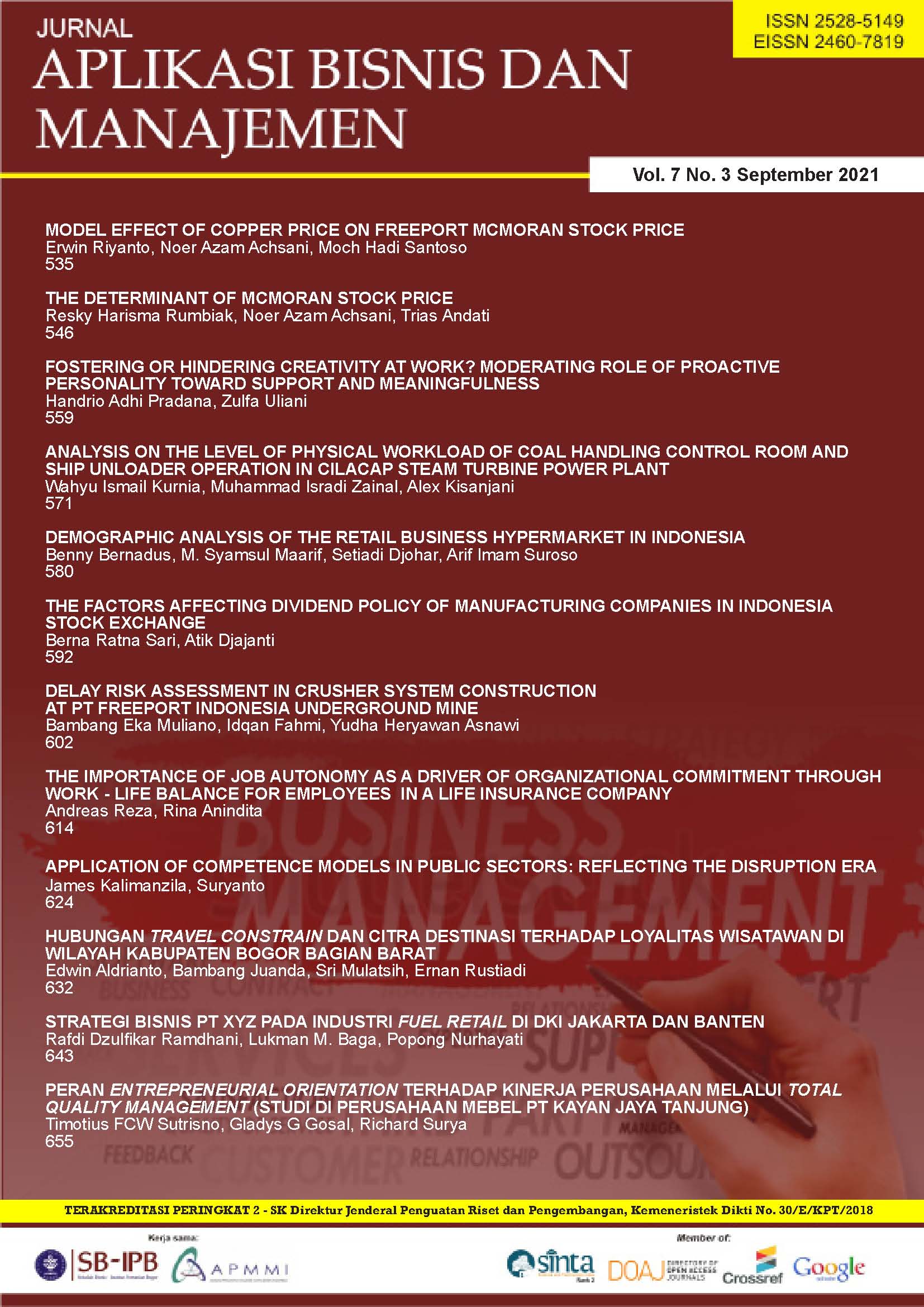HUBUNGAN TRAVEL CONSTRAIN DAN CITRA DESTINASI TERHADAP LOYALITAS WISATAWAN DI WILAYAH KABUPATEN BOGOR BAGIAN BARAT
Abstract
This study aims to analyze the structural relationship between travel constraints and destination image on tourist loyalty. This was conducted in July-August 2019 in Tenjolaya Subdistrict and Pamijahan Subdistrict. The analysis using the PLS SEM method gives the result that the X3 construct (travel constraint) has a significant negative effect (-0.443) in influencing the X8 construct (visitor loyalty) as reflected in the interest in returning visits. This negative value is greater than the structural effect of the X4 construct (sense of place) which is only 0.390. It can be concluded that the destination that only relies on natural conditions has no significant effect on tourists' interest in making return visits if they have traveling constrain to the site.
Keywords: destination, rural, tourism, travel constraints
Downloads
References
Beerli Asuncion dan Josefa D. Martın. 2004. Factors Influencing Destination Image. Annals of Tourism Research. 31 (3) : 657–681.
Chen H. J, Chen P. J, Okumus F. 2013. The relationship between travel constraints and destination image: A case study of Brunei. Tourism Management (35): 198–208.
Chin, W.W. (1998). The partial least squares approach to structural equation modeling. Di dalam G. A. Marcoulides (Ed.) : Modern methods for business research : 295-336). Mahwah, NJ: Lawrence Erlbaum Associates.
Chon Kye-Sung. 1990. The Role of Destination Image in Tourism: A Review and Discussion. The Tourist Review (2) :2-9
Dimitrovskia Darko Dragi, Aleksandar Tomislav, TO Drovića Aleksandar, Djordje Valjarevićb. 2012 Rural Tourism and Regional Development: Case Study of Development of Rural Tourism in the Region of Gruţa, Serbia. Procedia Environmental Sciences (14) : 288 – 297: Published by Elsevier Ltd
Garau Chiara. 2015. Perspectives on Cultural and Sustainable Rural Tourism in a Smart Region: The Case Study of Marmilla in Sardinia .Italy.. Sustainability (7): 6412-6434
Gartner W. 1993. Image Formation Process. In M. Uysal, & D. Fesenmaier .eds.. Communication and Channel Systems in Tourism Marketing : 191–215
Hair, Joseph F., Marko Sarstedt , Lucas Hopkins , Volker G. Kuppelwieser , .2014. "Partial least squares structural equation modeling .PLS-SEM.: An emerging tool in business research", European Business Review. 26 (2): 106 – 121
Ionela Gavrilă-Paven, Bârsan Mircea Constantinb, Lia-Dorica Dogaru. 2015. Advantages and Limits for Tourism Development in Rural Area .Case Study Ampoi and MureúValleys.. Procedia Economics and Finance (32): 1050 – 1059
Ismanto Hadi. 2018. Kepuasan Konsumen Dan Kinerja Keuangan UKM Di Kabupaten Jepara. Jurnal Aplikasi Manajemen dan Bisnis, 4 (3) : 377-386
Jaya, I. G., & Sumertajaya, I. M. 2008. Pemodelan Persamaan Struktural Dengan Partial Least Square. Semnas Matematika dan Pendidikan Matematika 1 : 118-132.
Jepson D dan Sharpley, R. 2015. More than sense of place? Exploring the emotional dimension of rural tourism experiences. Journal of Sustainable Tourism 23 (8):1-22
Kim Dohee dan Richard R. Perdue. 2013. The effects of cognitive, affective, and sensory attributes on hotel choice. International Journal of Hospitality Management 35: 246– 257
Koster Rhonda L. 2019. Why Differentiate Rural Tourism Geographies? Di dalam : Koster Rhonda L and Doris A. Carson (eds) : Perspectives on Rural Tourism Geographies : 1-13: Springer Publication. Cham, Switzerland
Kurniawan Hendra, Arif Satria dan Gendut Suprayitno. 2016.Perancangan strategi bauran pemasaran untuk meningkatkan Kepuasandanloyalitasnasabah pembiayaan umrah. Jurnal Aplikasi Manajemen dan Bisnis, 2 (2) : 32-42
Leiper N. 1979. The framework of tourism: Towards a definition of tourism, tourist, and the tourist industry. Annals of Tourism Research 6: 390-407.
Mitchell Morag dan Derek Hall. 2005. Rural Tourism as Sustainable Business: Key Themes and Issues [Chapter 1]. In : Derek Hall, Irene Kirkpatrick and Morag Mitchell (Eds) : Rural Tourism and Sustainable Business : 3-14 : Channel View Publications. Clevedon • Buffalo • Toronto
Neumeier Stefan, Kim Pollermann. 2014. Rural Tourism As Promoter Of Rural Development – Prospects And Limitations: Case Study Findings From A Pilot Projectpromoting Village Tourism. Europ.Countrys. 4: 270-296.
Pike S, dan Ryan C. 2004. Destination positioning analysis through a comparison of cognitive, affective, and conative perceptions. Journal of Travel Research, 42 (4): 333–342.
Rosiyanti Adnin Widya & M.H. Dewi Susilowati. 2017. Perkembangan Objek Wisata di Kabupaten Bogor.8th Industrial Research Workshop and National Seminar Politeknik Negeri Bandung, July 26-27, 2017
Ritchie, B.J. & Crouch, G.I. 2005. The Competitive Destination: A Sustainable Tourism Perspective : Wallingford : CABI Publishing.
Schubert, D. 2006. Active regions–shaping rural futures: A model for new rural development in Germany. In Diakosavvas D.(Ed) : Coherence of Agricultural and Rural Development Policies : pp. 333–352 : OECD Publishing: Paris, France, 2006
Sharpley, R., dan Pearce, T. .2007.. Tourism, marketing and sustainable development in the English national parks: The role of national park authorities. Journal of Sustainable Tourism, 15 (5) : 557-573.
Tasci A.D.A. 2007. Assessment of factors influencing destination image using a multiple regression model. Tourism Review, 62 (2) : 23 – 30
Yuksel A, Yuksel F, dan Bilim, Y. 2010. Destination attachment: effects on customer satisfaction and cognitive, affective and conative loyalty. Tourism Management, 31(2): 274–284.








